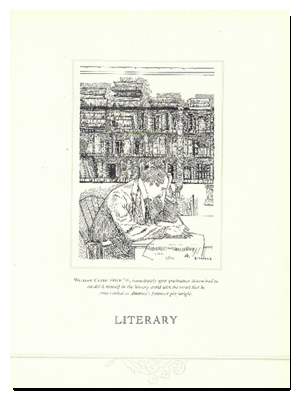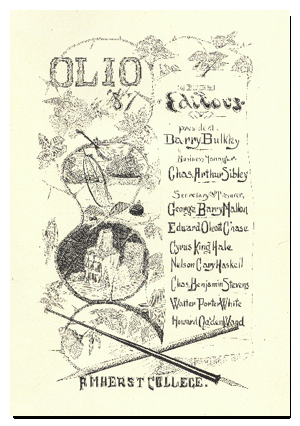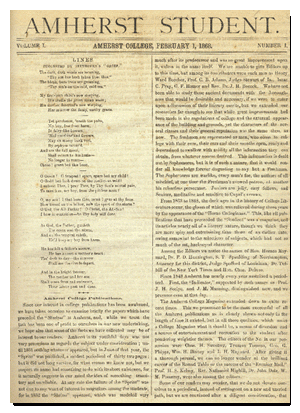For an in-depth look at student publications, see Amherst Reacts -- the final project of the 2016 Digital Scholarship Summer Interns.
Many Voices: Selections from the Student Publications Collection
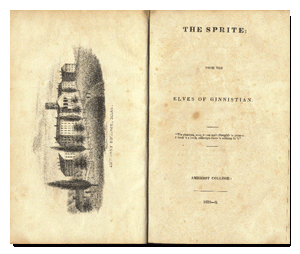
|
The Sprite was the first periodical of any kind issued by the students of Amherst College. It was started as a private enterprise and first appeared in June 1831. The Sprite lasted until March 1832 with only six issues published. It was originated by several members of the class of 1832 who called themselves by the fanciful name "Elves of Ginnistian." The prospectus for this short-lived publication stated that the work would be "devoted to essays upon matters of taste, of fancy and feeling - amusing tales, poetry, and all the various descriptions of miscellaneous writings which may interest, please, and instruct." The authors hoped that in time The Sprite would become "a repository of College Thought." The cause of The Sprite's early death is not clear, but it is recorded that as a private enterprise it may never have gained general financial support, and there appears to have been a lack of harmony among the "Elves" themselves.
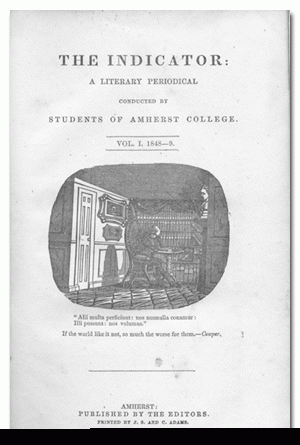
|
The Sprite was followed by similarly short-lived periodicals: The Shrine (later in 1831); Horae Collegianae (1837-40); and, in June 1848, published by the Class of 1849, The Indicator: A Literary Periodical Conducted by the Students of Amherst College. It was published monthly from 1848 to 1851, with editorial management residing each year in members of the senior class. In the "Prolegomena" to the first issue, the editors tried to distinguish The Indicator in origin and character from other periodical literature of the time, remaining strictly local in "design and conduct" and seeking support only within their "own narrow circle." The editors wrote: "Our only promise is to indicate the literary taste, spirit, and acquirements, of the undergraduates of Amherst College: -our chief aim to raise these to the highest attainable standards..." The issue for February 1850 included the earliest publication of writing by Emily Dickinson, a Valentine letter presumably sent to one of the editors.
The Olio
When preparing a history of its own evolution, the Olio editors used Skeat's Etymological Dictionary definition of olio: "a mixture, medley." Known to the Amherst College community today as the College yearbook, the Olio has a rocky start. Initiated in October 1855 in newspaper form as the College Olio, it was followed by several newspaper-like publications, calle the Amherst Aurora and later the Amherst College Olio. These early versions were more like a combination of college catalogue and student newspaper than today's yearbook. In 1861, the Olio was first published in pamphlet form, which, according to the editors, "gave it a distinctive position in the college world." The Olio was then produced by the junior class. In 1871, the Olio introduced the widely popular Class Histories feature, which marked the beginning of the modern era and eventually added distinguished drawings and photographs.
The sketch of playwright Clyde Fitch (Class of 1886) by L. Humphrey Walz '31 (a descendant of the College's second president, Herman Humphrey), which introduced the literary activities section of the 1931 Olio, illustrates the continued use of student art work as an integral part of the design for the College yearbooks.
The Amherst Student, first published on February 1, 1868, has been the voice of the College student body for more than 130 years. The earliest editors believed they were embarking on "a new and untried path" with this publication, which was not to be devoted to literary and philosophical essays and articles like previous College publications. Rather, they saw The Amherst Student as complementary, published more frequently than other periodicals and focusing on "topics immediately associated with college life, and a summary of college news" that would make the paper interesting to students, to alumni, and to others who wanted to "keep themselves well informed as to what is transpiring at the college and what agitates the college mind." The editors felt that the topic of College publications was so important that it was the lead article for the first issue.
Headline Review
In 1939, the Amherst Student introduced the Headline Review, a summary of the year's events as reported in the Student. Issued in December for just three years (1939-41) this publication carried the volume designation of the Student. With the Headline Review, the editors strayed from their "normal self-imposed restrictions - those of merely reporting the news." For this publication they included many editorial comments which conveyed the editor's views "on a significant year at Amherst." As the editors stated in the foreword to the 1940 Headline Review, they tried to present a "concise resume of the whole College scene" which they hoped would "stay with [the reader] for a long time." The December 1940 issue is pictured here.
The Medusa
The Medusa was edited by James Merrill '47 and William Buford '49. The magazine contained articles and poems by Amherst College professors, outside writers (including Anaïs Nin), and the editors. The Medusa was named for a group organized in the fall of 1945 by students interested in contemporary writing, with the multiple purposes of furthering interest in modern literature and the allied arts, encouraging individual creative expression, and bringing to campus stimulating speakers who would focus on the new and provocative. Though The Medusa was published independently of the College, it was associated with the group. The editors wrote: "In this first issue appears the work of members of the group and their guests during the past year... Whether the magazine will continue and, if so, at what intervals, remains to be seen." Alas, volume 1, number 1, fall 1946 was the only issue of The Medusa published.
Paideia
Established in early 1965 "on the premise that people at Amherst are interested in what their fellows are doing," Paideia was the work of several current members of the Friends of the Library during their undergraduate years. Friends Chairman Sam Ellenport '65 served as the Assistant Editor for the earliest issues. Council member Ron Gordon '65 designed the first two issues. They and other members of the Friends contributed articles to the journal during its ten year life. The founder, Thomas Weiskel '67, wrote, "We hope to present in the Paideia some of the interesting and original work that is the core of Amherst's excellence...a sketchy symbol of the constant if not spectacular intellectual activity that we take for granted at Amherst." The journal's title is the English form of the Greek word meaning "learning" or "education." Paideia was published until 1974; the second issue, for spring 1965, is illustrated here.
